Not using your motorhome, campervan or RV during winter? Want to winterise your motorhome and shut it down for the cold months? Here’s everything you need to do to prepare your vehicle for winter storage and how to care for it during winter lay-up, as well as things to do AFTER winter to get back on the road again.
Get your FREE motorhome winter storage checklist below to remember everything you need.
*We work hard to make this the best motorhome travel blog and road trip website possible, full of helpful content for you. The website is supported by our readers, so if you buy through links on this site we may earn a commission- at no extra cost to you. All opinions remain our own.
If you find this post useful, you can also treat us to a coffee – we promise to enjoy it while creating more useful content like this- we might even indulge in a biscuit (or two!)
Winterise a motorhome- what is that?
There are two types of ‘winterising’ when it comes to motorhomes or campervans (and no, I don’t mean the spelling of winterizing for my overseas RV readers! ? )
The first type is to prepare a vehicle for use during the cold winter months, such as if you want to go skiing with your motorhome or live in your motorhome during winter.
The second is preparing your vehicle for winter storage and not being used very much during winter (also commonly called ‘laying up’.)
In this post, we’re going to be talking about shutting down and preparing your motorhome for winter storage and how to care for your motorhome while it’s not being used.
As you’ll see below, it’s important to ensure your motorhome, campervan or caravan is properly closed down when not being used for periods of time, otherwise you could end up with damp, condensation and many other issues in your van.
RELATED: Want to experience winter vanlife or planning a winter motorhome trip? Read this first…
FREE Motorhome Winter Storage Checklist
Don’t forget to grab your free motorhome winter shutdown and storage checklist, so you can make sure you have and do everything you need to in order to properly care for your motorhome or camper throughout winter.
This also applies for anytime you won’t be using your vehicle for a while, like during a global shutdown…!
Shutting down your motorhome/ camper for winter?
Grab your FREE winter shutdown checklist here
Why winterise your motorhome or camper?
There are two main reasons we recommend following these winter motorhome storage tips
The first reason to prepare your motorhome properly for winter is to avoid problems from the cold, like damp, mould and burst pipes. Most damage done to motorhomes occurs during the winter months- especially COLD winter months.
Cold weather can also cause problems with tyres, seals, engines and other essential parts!
The second reason to winterise your motorhome is to comply with motorhome insurance policies.
Many insurers state that they will not cover damage caused by water freezing inside the motorhome or camper systems (including the heating system) between November and March.
(Check your insurance policy to know exactly what rules you need to comply with.)
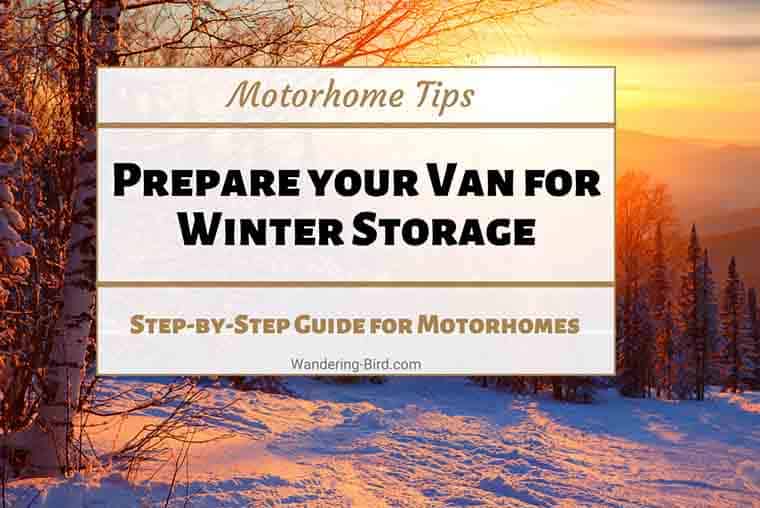
When should you prepare your motorhome for winter storage?
I would recommend following these steps as soon as it starts to get frosty so you avoid potential problems, particularly if the weather is going to be approaching 0ºc and things might start to freeze!
Obviously, this only applies if you’re not going to be using your motorhome- if you are planning to use your motorhome regularly throughout winter, you don’t need to follow these steps.
READ MORE: 27 essential motorhome tips for beginners
Where to store a motorhome for winter
There are several places where you can store a motorhome over winter:
- Parking on your driveway (or that of a friend/ relative)
- Street parking near your house
- Secure motorhome storage outdoors
- Secure motorhome storage indoors
If you don’t have a permanent motorhome storage place, you’ll need to book your winter motorhome storage as soon as possible- they get booked up quickly.
Many farmers offer barns for indoor storage, and there are plenty of secure outdoor motorhome storage places around- just Google.
Personally, I would hesitate to keep my motorhome on the street long-term- it’s too easy for thieves to spot and scope out. If you do choose to do this, make sure you add at least one of these additional motorhome security measures.
Storing motorhome at home
The tips listed in this post are useful regardless of where you store your motorhome during winter– in a storage yard or on your driveway.
Some things are easier to do at home and some may be forbidden in the motorhome storage unit (like draining down your system), but there are plenty of other places to get that done.
Also, if you want to keep your motorhome battery charged and looked after, you may have to take it home with you if you don’t store your motorhome/ camper on your drive; many motorhome storage units don’t have or allow power supplies.
READ MORE: How to care for your motorhome leisure battery during winter
Again, if you are storing your camper at home, make sure to fit some additional motorhome security devices; thefts of motorhomes (and other vehicles) increases over winter, especially in the run-up to Christmas.

How do you winterise and store a motorhome for winter?
Ok, deep breath. This section may all sound overwhelming, but I promise it’s not that bad. A little effort now will save a lot of trouble in a few months time.
Step 1- empty nearly everything!
- Empty out all perishables (food, drinks etc). We often leave our canned foods in the motorhome, but we do remove any fizzy drinks- just in case! Remember to remove spices, flour etc as these can attract bugs if left.
- Remove ALL linens and clothes. Anything which can easily mould. This includes coats, towels, bedding, mattress & seat cushions. Some people remove their curtains too- we never have but it’s personal preference.
- We also remove toilet and kitchen rolls, which only go soggy if left behind.
- All personal hygiene soaps, liquids and sanitary protection
- Take out ALL valuables, especially electronics. Remove motorhome sat-navs, speakers, torches, battery lights, fairy lights- we often find the battery terminals can corrode if left too long in the cold/ damp.
- You might also want to move any campervan and motorhome gadgets you carry onboard.
- Remove motorhome books, magazines, photos and any other paper based product.
- If you have a motorhome logbook or journal, remove that too. You can leave owners manual in if you wish, but there’s a chance it could get damaged.
Step 2- what can you leave in the motorhome over the winter?
It’s ok to leave some things inside your motorhome/ RV/ camper over winter. Admittedly, some things will depend upon whether or not you’re leaving it plugged in and leaving heating on in the van, but here’s a helpful guide for you of things we leave in the van over winter:
- Pots/ pans (cleaned!)
- Crockery/ cutlery/ glassware (cleaned!)
- Motorhome Cleaning supplies (you can choose to remove the liquids if you wish. We never have, but then we don’t live anywhere it gets REALLY cold)
- Some people choose to leave their first aid kit/ medicines. We choose to remove ours, but that’s only so we can use it over winter if we need to
- Games
- Motorhome Generator (drained)
- Dog bowls/ toys (because you just know I’ll forget them otherwise!) – Here’s a list of our essential dog road trip accessories
- Smoke alarm/ Carbon monoxide detector (yes, with batteries in. Just in case)
- If you have an external motorhome storage box on the rear, you can probably leave most of the gear in there (make sure it’s locked up and watertight), but do a quick check first to be sure there’s nothing perishable inside.
Can I leave a TV in my RV motorhome over winter?
Yes. There is no reason to remove your TV, EXCEPT for the fact that thieves could target it.
READ MORE: The best 12v motorhome TVs on the market
Motorhome winterisation tips- cleaning
- Once everything is out, give it all a REALLY good clean, inside and out! This is a good time to apply a coat or two of wax to the outside.
- Check awnings are totally dry before storing them away
- Check fridge/ freezer are empty & clean. Leave the door hooked ajar (there’s often a locking setting on the fridge door catch which you can pull out to leave it ajar)
- Prevent against condensation & mould. Leave all lockers, cupboards, wardrobes etc ajar. Learn how we stop condensation in our motorhome here.
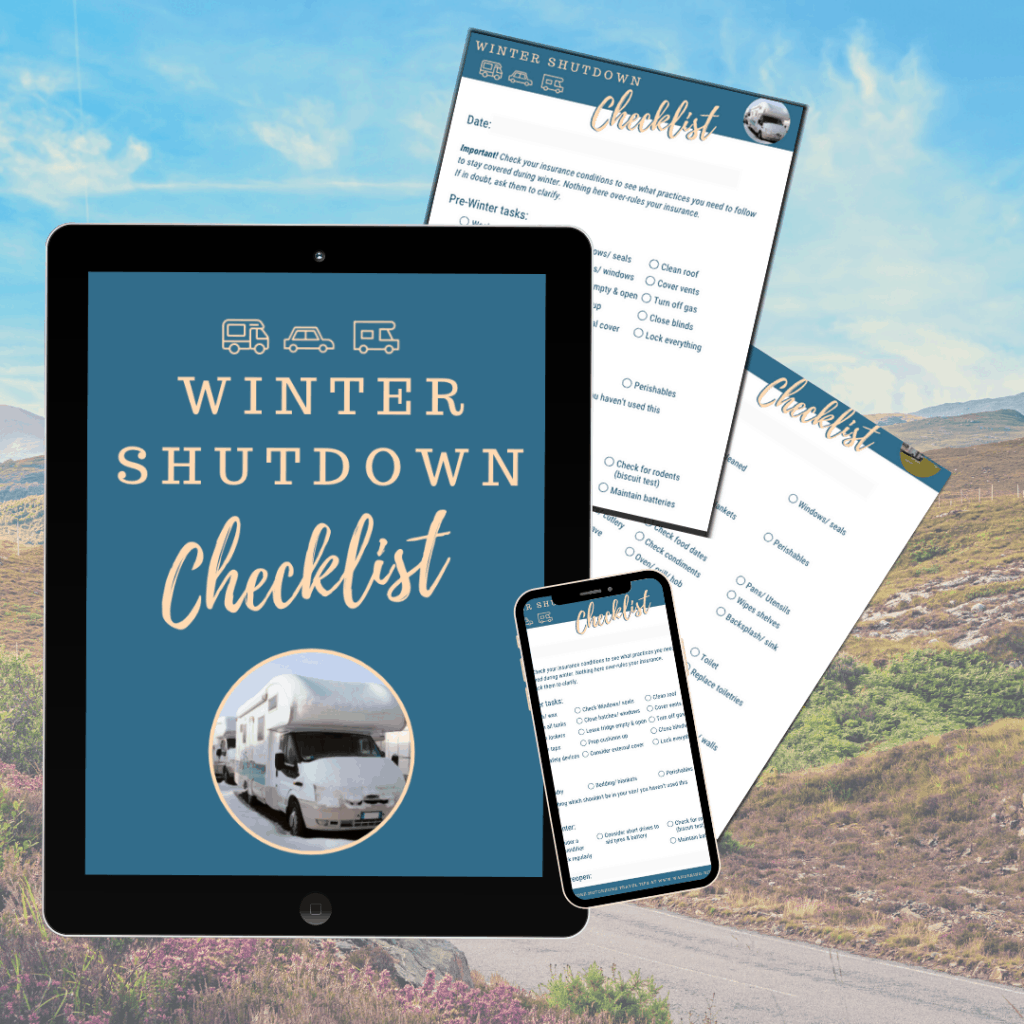
Shutting down your motorhome/ camper for winter?
Grab your FREE winter shutdown checklist here
Winterising a camper tips- Top things up!
Once you’ve emptied and cleaned, think about the things you are leaving behind, and top up any fluids which will be staying in the vehicle, including:
- LPG Gas cylinders. Refill Gaslow cylinders if you have them. If you have exchangeable cylinders, it might be best to remove them completely and store them at home (yes, you’re going to lose your spare bedroom for the winter!). This is also a good time to TURN OFF all gas bottles and also the main supply into the motorhome.
- Put Anti-freeze in engine (we’ll get to using antifreeze inside your motorhome plumbing in a bit)
- Engine Oil
- Motorhome Fuel
- Check tyre pressure (also check tread and make sure there is no cracking/ damage before winter starts- cold weather won’t help that at all!)
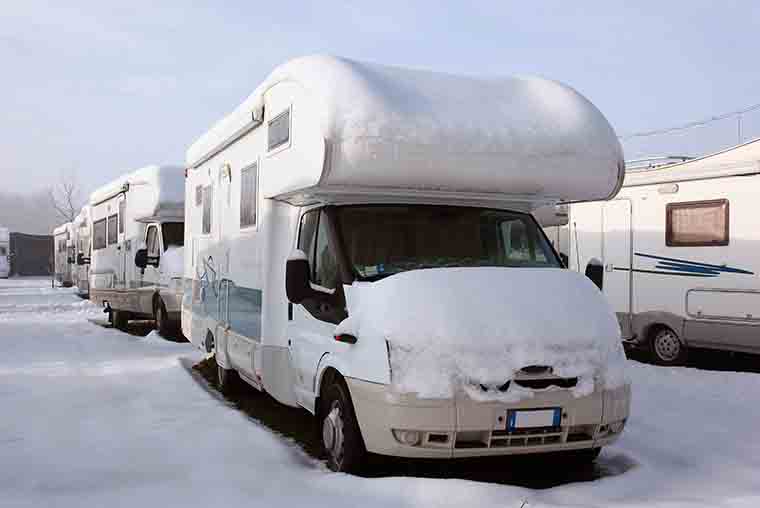
Motorhome Winter Storage Tips- How to drain down your camper
DISCLAIMER: This is a generic guide. Most motorhome systems are very similar, but please do check your owner’s manual before following these steps. If in doubt, ask your dealership or a local garage for advice on your specific model.
- Empty ALL systems over a suitable drainage point. (If you can angle your motorhome to get as much as possible out, even better!) You might want to clean your motorhome water tank first (here’s how.)
- Make sure you have emptied: freshwater, wastewater, water heater tank and toilet flush (if separate from freshwater) (Make sure your toilet is empty too…!) You may prefer to buy a water heater bypass kit instead.
- Open all internal taps (yep, while over the drain)- LEAVE these open all winter.
- If you have a mixer tap, open it in the middle so both sides are on.
- If you have inline water filters, disconnect and empty these.
- Leave the water pump running until taps run dry (then turn it off quickly to avoid pump burnout)
- Remove the showerhead and drain water from the hose. Leave the hose hanging onto the bathroom drain (if you have a wetroom/ shower room) or a bowl if you have carpet.
- Check underneath the motorhome and make sure the u-bends are as empty as possible (this is normally where the shower u-bends are)
- If possible, go for a quick drive to bump things around and make sure everything is as clear of water as possible.
- Also, don’t forget diesel and petrol have a shelf life. Now is the time to check motorhome generators, motorbikes or anything else in the van which uses fuel and either drain it down completely or check the fuel to be sure it’s still ok.
Winterize drain down Kit for RVs, Motorhomes and Campers
For the best results, you need to push air through the system to get all the water out. This is the best kit we’ve found.
Should you use antifreeze when preparing your motorhome for winter storage?
If you don’t use a drainage kit like the one above, there may be some water left in your ‘u’ bends. You can add a little antifreeze down the plughole to help stop this freezing (especially in sinks and to the toilet cistern.)
Should you use motorhome antifreeze in the freshwater tank?
DON’T add antifreeze to your freshwater pipe unless it’s special RV motorhome antifreeze which is non-toxic!!! This is a safe non-toxic antifreeze to use in drinking water systems.
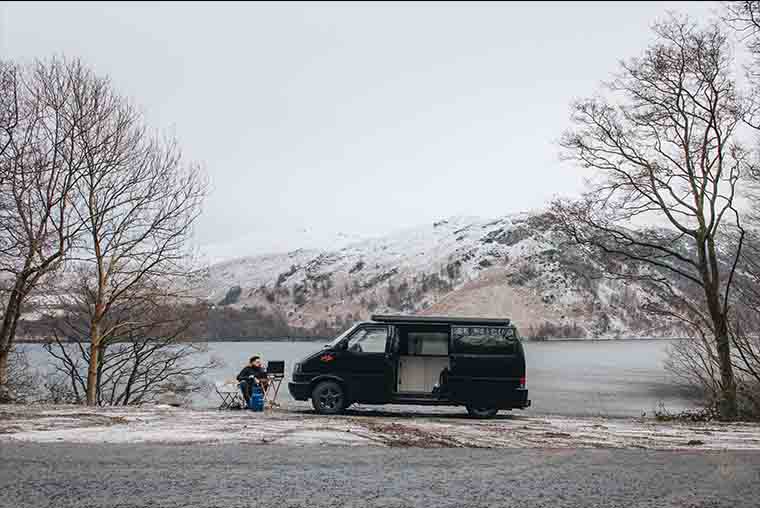
Winter RV Motorhome Tips- Battery winter storage & care
First, make sure both your motorhome leisure battery and your engine battery are fully charged.
Engine batteries tend to fare better in winter, but leisure batteries, especially those housed in external lockers, often fail in cold weather.
This can be caused by the age of the battery, but can often be caused if the temperature drops very low. Try and avoid this by leaving the leisure battery on a trickle charge, such as from a solar panel, or you can even remove the battery completely and store it at home for the winter.
NOTE: Even if stored at home, batteries will need top-up charging every 4-6 weeks to prevent problems.
READ MORE: Complete Guide to caring for your motorhome leisure battery
Should you cover your motorhome in winter?
Ideally, you want to store your motorhome or campervan indoors during winter. If that’s not possible then yes, a motorhome cover is a good idea. The more layers of insulation the motorhome has, the better.
However, be sure that you use a breathable cover, like this, otherwise the air won’t circulate and you’ll cause mould and damp. (Be warned- they are NOT easy to put on!!) You also want to make sure you get one which fits your vehicle AND which allows access to the habitation door.
Some people just choose to cover their windscreen- and you might choose to leave your wiper blades hinged away from the windscreen so they can’t freeze in place.
Preparing your motorhome for winter- other tips
- If you are able to connect to power, leave a small heater on low/ night time setting to guard against freezing.
- Fit exterior vents to fridges and leave fridge door open
- Leave cabinets and interior doors open to allow air to circulate
- You can spray a little WD-40 on catches, locks and some electrics to prevent rust or corrosion.
- Ensure all protective systems are working ok- alarms, trackers etc. You may wish to install extra security measures like an additional habitation door lock– winter is a common time for thieves to strike.
Don’t forget to grab your FREE RV motorhome winter storage checklist

Shutting down your motorhome/ camper for winter?
Grab your FREE winter shutdown checklist here
Protect your motorhome from rodents- The biscuit test!
It’s a sad fact that a motorhome or campervan left alone for a while will attract various animals looking for a home. Mice, rats and spiders can all move in during your absence.
One of the best tricks we’ve heard of is the biscuit test.
Put a tiny piece of biscuit on the floor in the motorhome when you leave it for winter. If it’s still there when you return, you don’t have any mice or rats as residents!
Sadly, we don’t have any good tricks to deter spiders. Conkers, laundry sheets and blocking holes with tissue may help- but don’t forget you need to leave some ventilation into the van… which means holes. Vicious circle, unfortunately.
Things to do DURING winter storage and shut down
Once your motorhome is prepared and tucked away for the winter, you can’t just forget about it for 5 months (although I doubt you’ll forget anything- winter is the BEST time to plan your next epic motorhome trip.)
Still, there are some things you need to do during winter shutdown to look after your van. Don’t forget, motorhomes and campers are built on the same chassis as workvans. They are not designed to be sat idle for months on end.
In order to prevent issues after being stood for long periods, you need to do the following at least once a month if possible:
- Check on your motorhome if it’s not parked near you
- Look for signs of mould or damp and deal with any potential problems asap- leaving it only makes it worse!
- Start the engine and ideally go for a short drive (at least 20 minutes)
- Leave gearbox in neutral if possible and/ or don’t use the handbrake- or alternate between the two to try and limit wear. (This is when wheel wedges are useful.)
- If you can’t drive, run the engine for 30 minutes and rev in one minute intervals once it’s warm (this is not as good as driving it, and may cause build-up)
- Turn the air-conditioning on (ideally, while you’re driving the motorhome.) I know, it’s winter, and cold, but this really helps keep the system ticking over for whenever you next need it.
- Move the vehicle slightly so it’s not constantly on the same patch of tyre. Alternatively, use tyre savers to take the weight off, especially if your motorhome is over 3.5 tonnes.
- Tyre covers can be useful too to protect the brake discs.
While we’re on the subject of tyres, check (and open) your spare wheel casing if you have one. Many people never do this and the lock corrodes, meaning you can’t access the spare tyre when you need to!
Motorhome Winter Storage Tips- things to do AFTER winter
Finally, FINALLY, winter comes to an end and it’s time to start preparing for your next motorhome holiday. But, before you set off, there are some important things to check and do.
You can get a complete pre-trip & motorhome departure checklist here
- Reconnect anything which was disconnected, like the battery
- Check the battery is still serviceable. If in doubt, get it checked professionally
- Close any pipes left open
- Remove any vent covers, skirting or motorhome covers
- Check tyre pressure and drive vehicle to make sure there are no ‘flat spots’
- Do a full engine check, including oil and water levels.
- Give your engine a good run
- Check for any motorhome or campervan recalls for your model. Does anything need fixing?
- Fill fuel and gas
- Clean. Get your motorhome clean inside and out and be ready for the new season.
- Get a motorhome habitation check done, or do one yourself (but get the gas system professionally checked for your peace of mind.)
RELATED: Essential motorhome checks to make before every trip
I hope the above helps you prepare your motorhome for winter storage. If in doubt, please do contact a garage or motorhome dealer for advice on your specific model.
Want more motorhome tips? You can find them all here
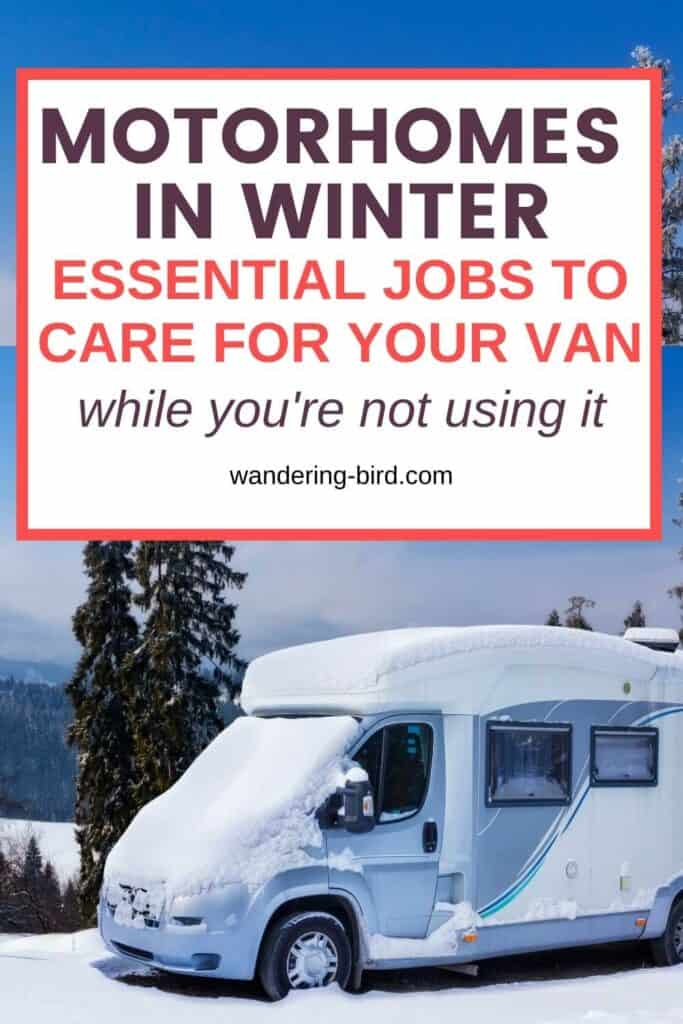
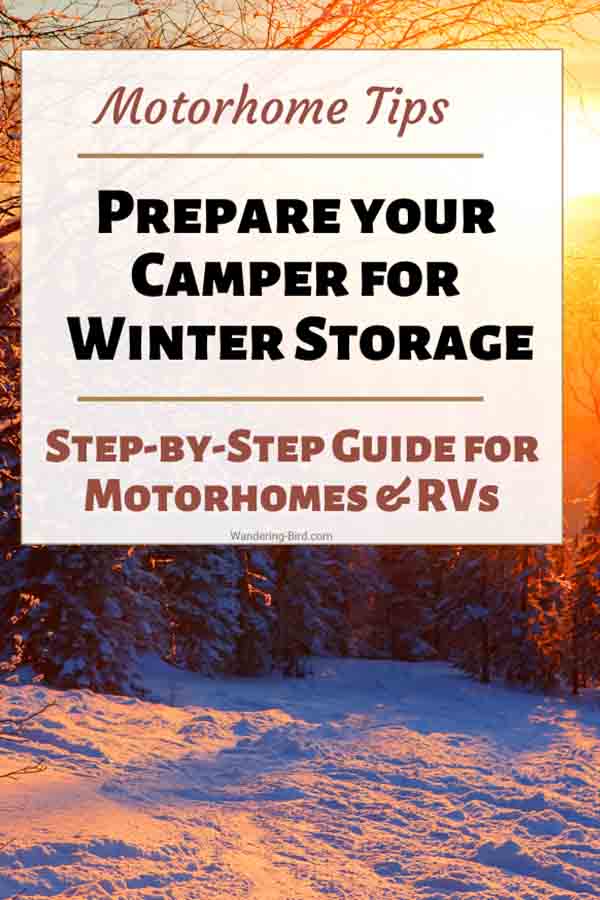

Last update on 2024-07-29 / Affiliate links / Images from Amazon Product Advertising API
